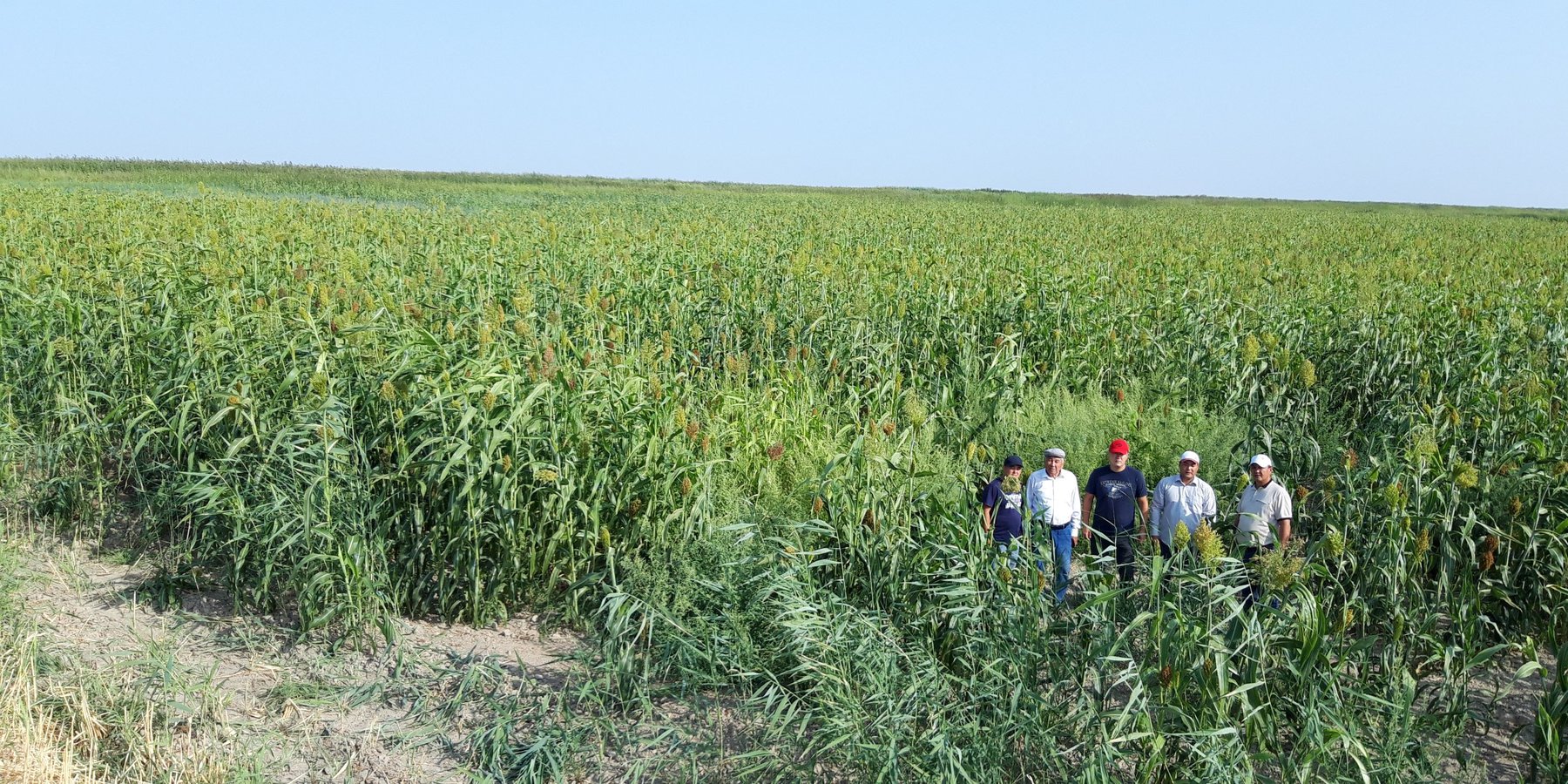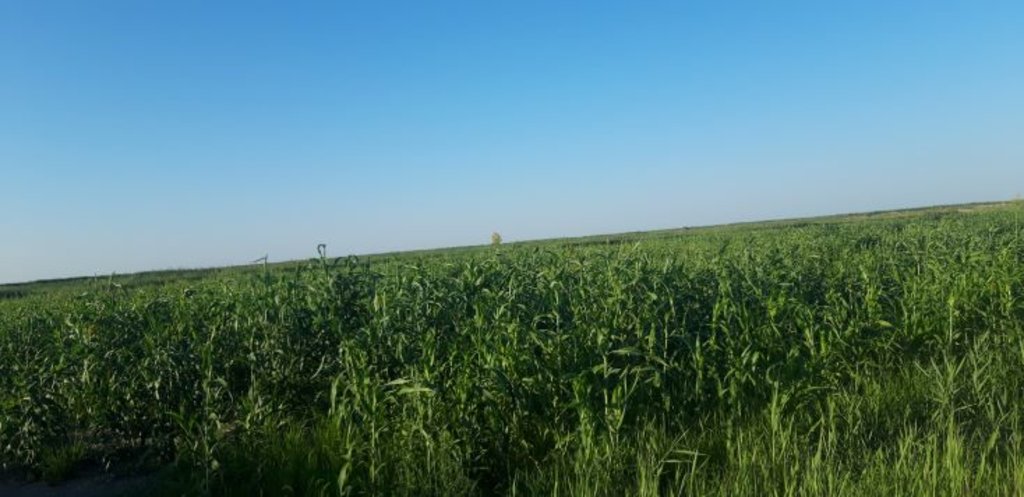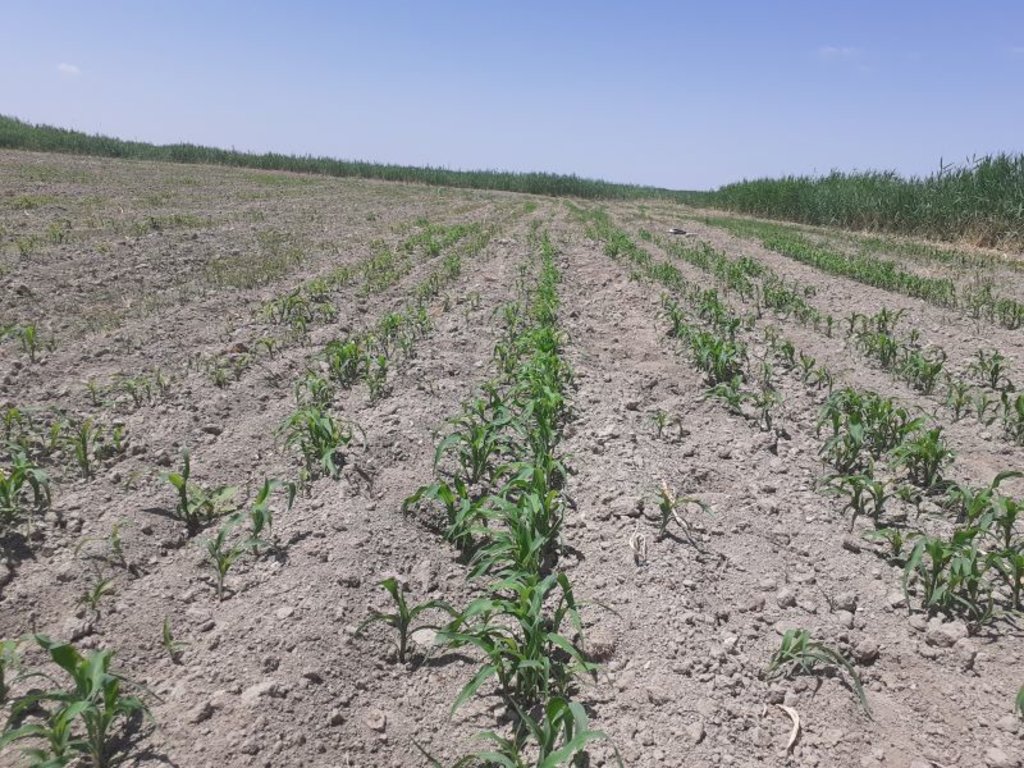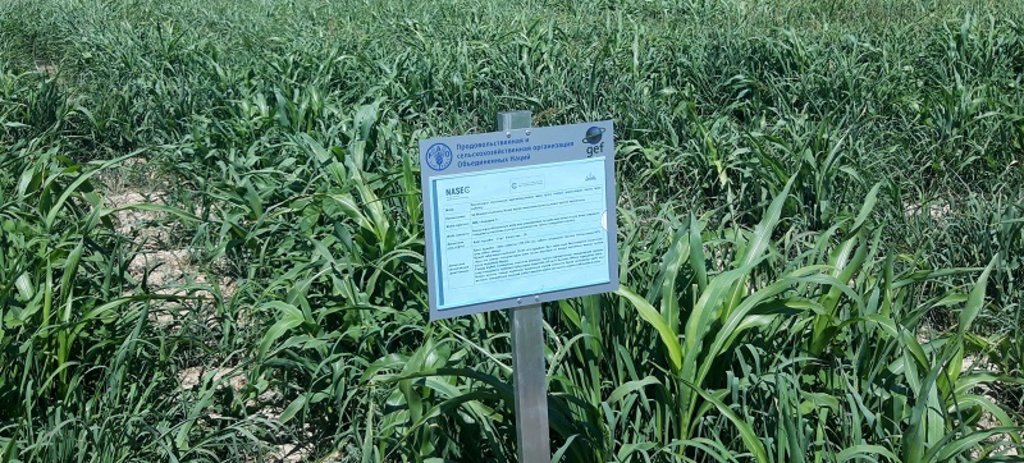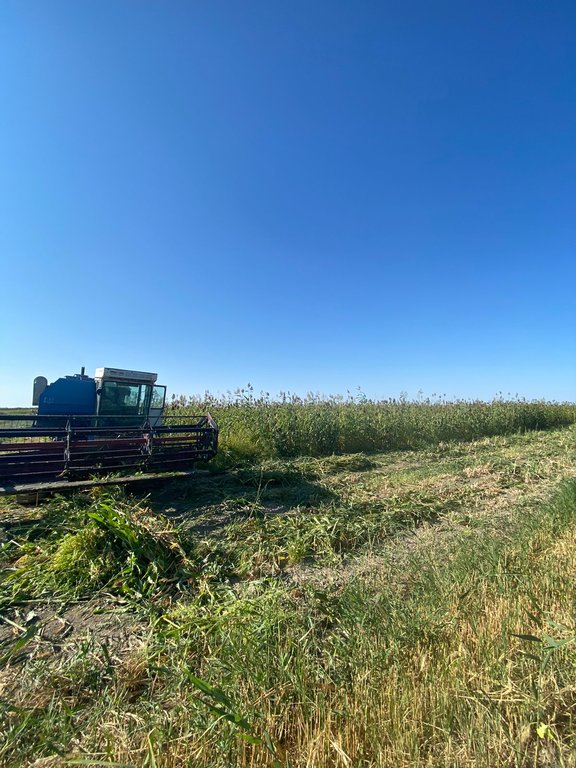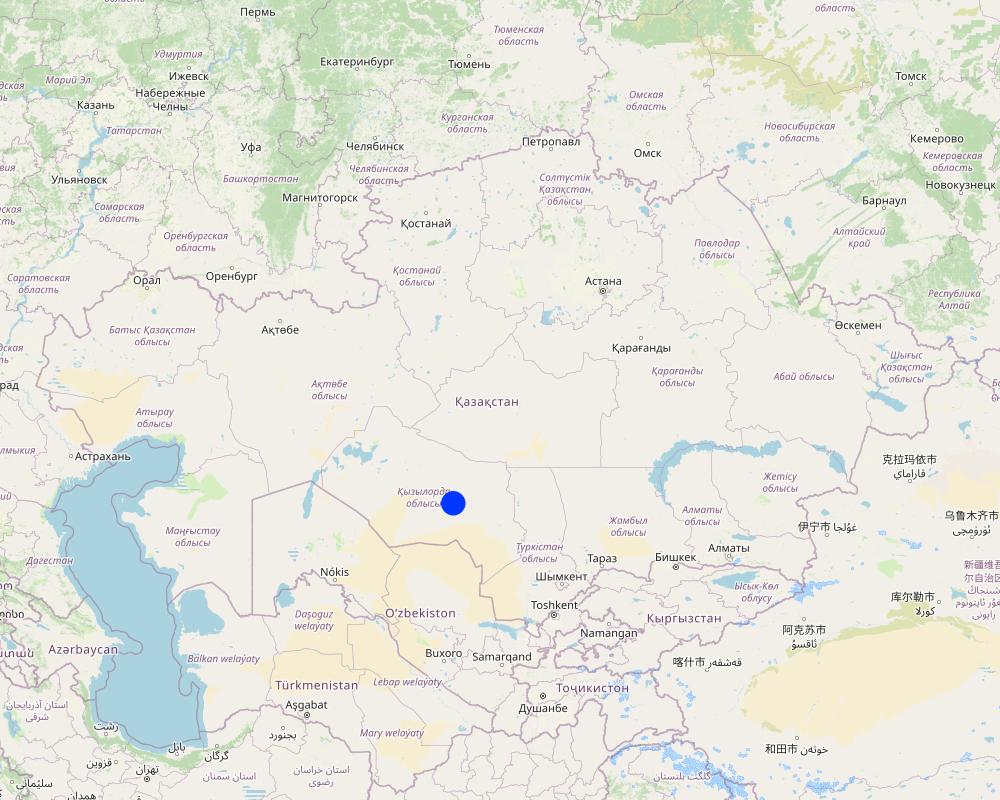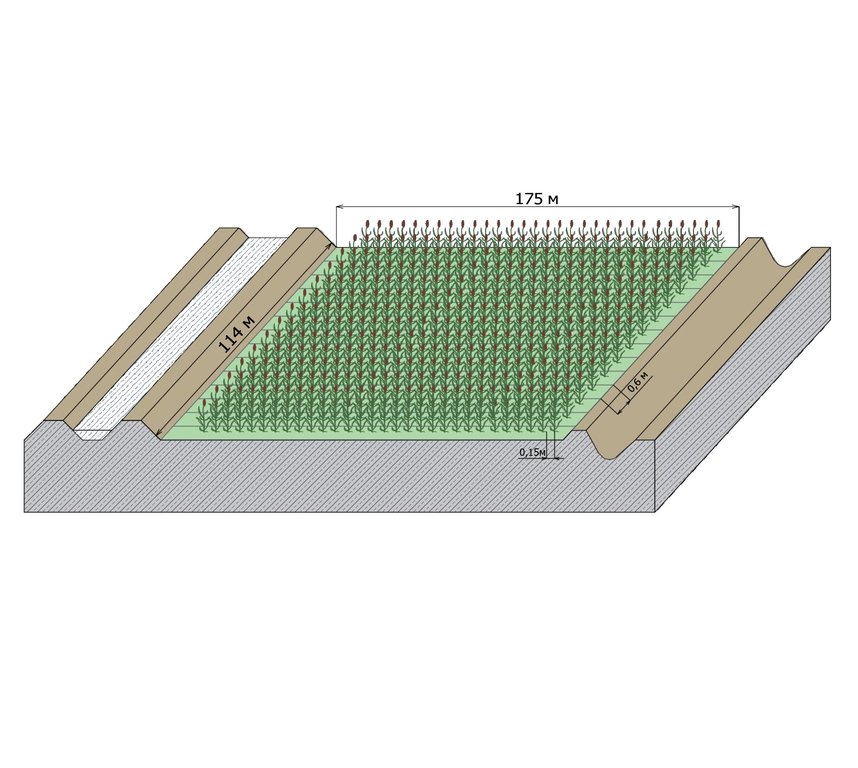Introduction of sweet sorghum into rice crop rotations to restore degraded saline lands and diversify agricultural production [Kazakhstan]
- Creation:
- Update:
- Compiler: Kulyash Iskandarova
- Editor: Hayot Ibrakhimov
- Reviewers: Rima Mekdaschi Studer, Olga Andreeva
-
technologies_6619 - Kazakhstan
- Full summary as PDF
- Full summary as PDF for print
- Full summary in the browser
- Full summary (unformatted)
- Введение сахарного сорго в рисовые севообороты для восстановления деградированных засоленных земель и диверсификации сельскохозяйственного производства: March 24, 2023 (inactive)
- Introduction of sweet sorghum into rice crop rotations to restore degraded saline lands and diversify agricultural production: Aug. 27, 2025 (public)
View sections
Expand all Collapse all1. General information
1.2 Contact details of resource persons and institutions involved in the assessment and documentation of the Technology
Key resource person(s)
SLM specialist:
Begaliyev Kanagat Bilalovich
Kazakh Research Institute of Rice Growing named after I.Zhakhaev
Kazakhstan
SLM specialist:
Name of project which facilitated the documentation/ evaluation of the Technology (if relevant)
Integrated natural resources management in drought-prone and salt-affected agricultural production landscapes in Central Asia and Turkey ((CACILM-2))1.3 Conditions regarding the use of data documented through WOCAT
The compiler and key resource person(s) accept the conditions regarding the use of data documented through WOCAT:
Yes
1.4 Declaration on sustainability of the described Technology
Is the Technology described here problematic with regard to land degradation, so that it cannot be declared a sustainable land management technology?
No
1.5 Reference to Questionnaire(s) on SLM Approaches (documented using WOCAT)
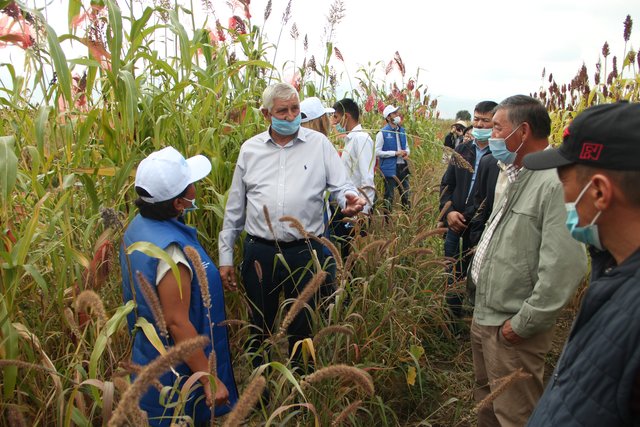
Распространение практик устойчивого землепользования путем организации демонстрационных участков … [Kazakhstan]
Организация пилотных демонстрационных участков и проведение Дней поля - мероприятия для региональных заинтересованных сторон, в основном фермеров, для получения информации о технологиях УЗП, приемах восстановления деградированных земель и пастбищ, перспективных для региона засухо- и солеустойчивых культурах и технологиях их выращивания, демонстрации результатов проекта ИСЦАУЗР-2 по расширению практики борьбы с засолением …
- Compiler: Kulyash Iskandarova
2. Description of the SLM Technology
2.1 Short description of the Technology
Definition of the Technology:
The introduction of sweet sorghum into rice crop rotations is one of the approaches to restoring degraded lands under conditions of irrigation water scarcity and secondary soil salinization, while also diversifying agricultural production in local communities through the development of a stable fodder base for livestock husbandry.
2.2 Detailed description of the Technology
Description:
Climate change and the resulting acute water deficit in the Shardara Reservoir and the Koksarai Counter-Regulator in recent years have become one of the main challenges for the agricultural sector of the Kyzylorda region, where rice cultivation is the dominant branch. Improving the socio-economic conditions of farming households is directly linked to the regulation of water consumption volumes and the efficiency of water resource use. One effective way to reduce dependence on water scarcity without compromising productivity and profitability is to diversify the cropping structure. For example, introducing low-water-demand and high-yield crops such as sweet sorghum into rice crop rotations.
1. Natural and Socio-Economic Conditions
The pilot site (Akzharma-1 farm) is located in the village of Akzharma, Syrdarya district, Kyzylorda region.
Agro-ecological conditions: The site lies within a semi-desert to desert arid zone. Soils are alluvial meadow-bog type with humus content of 0.6–0.8%. The average annual precipitation is 127–130 mm. The mean January temperature is –25.4°C, while in July it reaches +36°C. The elevation is 128 m above sea level.
Socio-economic profile of Akzharma village:
Population: 2,800 people
Households: 49
Registered small businesses: 162
Main livelihood activities:
Livestock husbandry: 3,478 head, including 2,150 cattle, 2,494 small ruminants, 1,166 horses, and 1,153 poultry.
Crop production: Rice (3,203 ha), alfalfa (1,472 ha), soybean (34 ha), potato (20 ha), vegetables (10 ha), melons (11 ha).
2. Key Characteristics of the Technology
Introducing sweet sorghum into rice rotations helps restore degraded saline soils, contributes to desalinization, and improves soil physical and chemical properties (pH, porosity, aeration, etc.). The technology supports diversification of local agricultural production, in particular by providing high-quality fodder for livestock, thereby strengthening opportunities for animal husbandry.
The technology has been implemented on a 20-hectare area within Akzharma-1 farm, Syrdarya district, Kyzylorda region.
3. Objectives and Functions of the Technology
Restore the fertility of saline soils by introducing alternative crops, specifically sweet sorghum, into rice crop rotations.
Maintain profitable agricultural production on saline soils under conditions of acute water scarcity.
4. Main Activities and Resources Required
Moldboard plowing to a depth of 25–27 cm (PLN-4-35 plow)
Leveling with MV-6 unit
Application of mineral fertilizers (N/P – 40/60 kg/ha) and incorporation with a BDT-7 harrow
Disking with BDT-7 harrow
Harrowing with BZT-1 harrow
Sowing sweet sorghum (Kazakhstan-16 or Kazakhstan-20) at a rate of 25 kg/ha (sown with SZT 3.6 m seeder in early April); sowing method – continuous row, row spacing 60 cm, seed depth 2–3 cm
Rolling with smooth rollers
Cultivation and additional fertilizer application
Harvesting for hay (late July–early August) with combine harvester
Estimated costs:
The cost of 1 ha, including soil preparation, seed, fertilizer, sowing, fertilizer application, and harvesting, is 94,015 KZT (USD 220.68).
5. Advantages and Impacts of the Technology
Restores degraded saline soils, contributes to desalinization
Promotes water and resource efficiency
Provides stable yields, even in dry years
Supports diversification of production and development of a strong fodder base for livestock husbandry
6. Farmers’ Perceptions
Positive aspects:
Opportunity to use severely degraded saline lands for profitable production under acute water scarcity
Guaranteed hay yields even in drought years
Negative aspects:
Additional costs for purchasing or renting equipment (cultivator, direct-harvest combine)
Limited availability of high-quality seed due to lack of specialized seed farms
2.3 Photos of the Technology
2.4 Videos of the Technology
Comments, short description:
INTRODUCTION OF SUGAR SORGHUM INTO RICE CROP ROTATION IN KYZYLORDA REGION.
Note: A link to the video with Russian subtitles can be found in section 7.3
Date:
22/09/2021
Location:
Syrdarya district, Kyzylorda region, Kazakhstan
Name of videographer:
Alexey Ganashilin
2.5 Country/ region/ locations where the Technology has been applied and which are covered by this assessment
Country:
Kazakhstan
Region/ State/ Province:
Kyzylorda region
Further specification of location:
Akzharma village, Syrdarya district
Specify the spread of the Technology:
- applied at specific points/ concentrated on a small area
Is/are the technology site(s) located in a permanently protected area?
No
Map
×2.6 Date of implementation
Indicate year of implementation:
2021
2.7 Introduction of the Technology
Specify how the Technology was introduced:
- through projects/ external interventions
Comments (type of project, etc.):
FAO-GEF Project “Integrated Natural Resources Management in Drought-Prone and Salt-Affected Agricultural Production Landscapes in Central Asia and Turkey (CACILM-2)” (GCP/SEC/293/GFF)
3. Classification of the SLM Technology
3.1 Main purpose(s) of the Technology
- improve production
- reduce, prevent, restore land degradation
- adapt to climate change/ extremes and its impacts
- create beneficial economic impact
3.2 Current land use type(s) where the Technology is applied
Land use mixed within the same land unit:
No
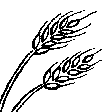
Cropland
- Annual cropping
Annual cropping - Specify crops:
- cereals - rice (wetland)
Number of growing seasons per year:
- 1
Is intercropping practiced?
No
Is crop rotation practiced?
Yes
If yes, specify:
sweet sorghum
3.3 Has land use changed due to the implementation of the Technology?
Has land use changed due to the implementation of the Technology?
- Yes (Please fill out the questions below with regard to the land use before implementation of the Technology)
Land use mixed within the same land unit:
No

Cropland
- Annual cropping
Annual cropping - Specify crops:
- cereals - sorghum
Is intercropping practiced?
No
3.4 Water supply
Water supply for the land on which the Technology is applied:
- full irrigation
Comments:
The only source of irrigation water is the Syr Darya River
3.5 SLM group to which the Technology belongs
- rotational systems (crop rotation, fallows, shifting cultivation)
- improved ground/ vegetation cover
3.6 SLM measures comprising the Technology
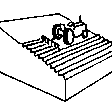
agronomic measures
- A3: Soil surface treatment
A3: Differentiate tillage systems:
A 3.2: Reduced tillage (> 30% soil cover)
3.7 Main types of land degradation addressed by the Technology
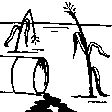
chemical soil deterioration
- Cs: salinization/ alkalinization
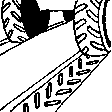
physical soil deterioration
- Pu: loss of bio-productive function due to other activities
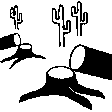
biological degradation
- Bc: reduction of vegetation cover
Comments:
The absence of drainage systems in rice fields, combined with the annual application of mineral fertilizers, leads to the formation of a subsurface ‘hardpan,’ which impedes the movement of air, water, and nutrients
3.8 Prevention, reduction, or restoration of land degradation
Specify the goal of the Technology with regard to land degradation:
- reduce land degradation
- restore/ rehabilitate severely degraded land
Comments:
The soils in the pilot areas are degraded and highly saline.
4. Technical specifications, implementation activities, inputs, and costs
4.1 Technical drawing of the Technology
Technical specifications (related to technical drawing):
Sowing sugar sorghum in rice paddies
The area of one rice paddy is about 2 ha (length – 175 m, width – 114 m);
The distance between rows is 60 cm;
The distance in a row between plants is about 15 cm.
Author:
Zhanuzak Baimanov
Date:
10/03/2023
Technical specifications (related to technical drawing):
The total area of sugar sorghum sowing in the Akzharma-1 farm was 20 ha (on 10 rice paddies).
Size of 1 paddy: length – 175 m, width – 114 m
Designations: A - Card irrigation system; B - Card discharge.
Author:
Zhanuzak Baimanov
Date:
10/03/2023
4.2 General information regarding the calculation of inputs and costs
Specify how costs and inputs were calculated:
- per Technology unit
Specify unit:
ha
other/ national currency (specify):
tenge
If relevant, indicate exchange rate from USD to local currency (e.g. 1 USD = 79.9 Brazilian Real): 1 USD =:
426.03
4.3 Establishment activities
| Activity | Timing (season) | |
|---|---|---|
| 1. | moldboard plowing to a depth of 22-25 cm (plow PN-8-35) | April |
| 2. | leveling and compaction of the topsoil layer with the MV-6 unit | April |
| 3. | application of mineral fertilizers (nitrogen/phosphorus - 40/60 kg/ha) | April |
| 4. | disking (harrow BDT-7) | April |
| 5. | harrowing (harrow BZT-1) | April |
| 6. | seed treatment with insectofungicides (PS-25) | April |
| 7. | sowing of sugar sorghum (Kazakhstan-16, Kazakhstan-20) with a seeding rate of 25 kg/ha (seeder SZT 3.6 m) sowing method - continuous row, with a row spacing of 30 cm, seed placement depth - 2-3 cm. | April |
| 8. | smooth roller rolling (SR) | April |
| 9. | Cultivation and fertilization | July |
| 10. | hay harvesting | August-September |
4.4 Costs and inputs needed for establishment
| Specify input | Unit | Quantity | Costs per Unit | Total costs per input | % of costs borne by land users | |
|---|---|---|---|---|---|---|
| Labour | Agrotechnical work (plowing, leveling and compacting the topsoil, fertilizing, disking, harrowing, seed treatment, sowing, rolling, cultivation and fertilizing, harvesting) | ha | 1.0 | 24144.05 | 24144.05 | 100.0 |
| Equipment | depreciation | ha | 1.0 | 19248.0 | 19248.0 | 100.0 |
| Equipment | current repairs, spare parts | ha | 1.0 | 3018.0 | 3018.0 | 100.0 |
| Plant material | sweet sorghum seeds variety Kazakhstanskoe-20 | kg | 25.0 | 150.0 | 3750.0 | |
| Fertilizers and biocides | ammonium sulfate | kg | 200.0 | 86.0 | 17200.0 | 100.0 |
| Fertilizers and biocides | microfertilizer Extrasol | l | 3.0 | 2000.0 | 6000.0 | 100.0 |
| Fertilizers and biocides | seed dressings Yunta | l | 0.0375 | 13000.0 | 487.5 | 100.0 |
| Other | fuels and lubricants | l | 108.06 | 174.0 | 18802.44 | 100.0 |
| Other | other expenses | ha | 1.0 | 1365.0 | 1365.0 | 100.0 |
| Total costs for establishment of the Technology | 94014.99 | |||||
| Total costs for establishment of the Technology in USD | 220.68 | |||||
If land user bore less than 100% of costs, indicate who covered the remaining costs:
Within the framework of the FAO-GEF project “Integrated Natural Resources Management in Drought-Prone and Salt-Affected Agricultural Production Landscapes in Central Asia and Turkey (CACILM-2)” (GCP/SEC/293/GFF)
4.5 Maintenance/ recurrent activities
| Activity | Timing/ frequency | |
|---|---|---|
| 1. | moldboard plowing to a depth of 22-25 cm (plow PN-8-35) | April |
| 2. | leveling and compaction of the top layer of soil with the MV-6 unit | April |
| 3. | application of mineral fertilizers (nitrogen/phosphorus - 40/60 kg/ha) | April |
| 4. | disking (harrow BDT-7) | April |
| 5. | harrowing (harrow BZT-1) | April |
| 6. | seed treatment with insectofungicides (PS-25) | April |
| 7. | sowing of sugar sorghum (Kazakhstanskoe-16, Kazakhstanskoe-20) with a seeding rate of 25 kg/ha (seeder SZT 3.6 m) sowing method - continuous row, with a row spacing of 30 cm, seed placement depth - 2-3 cm. | April |
| 8. | smooth roller rolling (SR) | April |
| 9. | Cultivation and fertilization | July |
| 10. | hay harvesting | August-September |
4.6 Costs and inputs needed for maintenance/ recurrent activities (per year)
| Specify input | Unit | Quantity | Costs per Unit | Total costs per input | % of costs borne by land users | |
|---|---|---|---|---|---|---|
| Labour | Agrotechnical works (plowing, leveling and compaction of the topsoil, fertilization, disking, harrowing, seed treatment, sowing, rolling, cultivation and fertilization, harvesting) | ha | 1.0 | 24144.05 | 24144.05 | 100.0 |
| Equipment | depreciation | ha | 1.0 | 19248.0 | 19248.0 | 100.0 |
| Equipment | current repairs | ha | 1.0 | 3018.0 | 3018.0 | 100.0 |
| Plant material | sweet sorghum seeds variety Kazakhstan-20 | kg | 25.0 | 150.0 | 3750.0 | |
| Fertilizers and biocides | ammonium sulfate | kg | 200.0 | 86.0 | 17200.0 | 100.0 |
| Fertilizers and biocides | microfertilizer Extrasol | l | 3.0 | 2000.0 | 6000.0 | 100.0 |
| Fertilizers and biocides | seed dressings Yunta | l | 0.0375 | 13000.0 | 487.5 | 100.0 |
| Other | fuels and lubricants | l | 108.06 | 174.0 | 18802.44 | |
| Other | other expenses | ha | 1.0 | 1365.0 | 1365.0 | |
| Total costs for maintenance of the Technology | 94014.99 | |||||
| Total costs for maintenance of the Technology in USD | 220.68 | |||||
If land user bore less than 100% of costs, indicate who covered the remaining costs:
Within the framework of the FAO-GEF project “Integrated Natural Resources Management in Drought-Prone and Salt-Affected Agricultural Production Landscapes in Central Asia and Turkey (CACILM-2)” (GCP/SEC/293/GFF)
4.7 Most important factors affecting the costs
Describe the most determinate factors affecting the costs:
The cost of fuels and lubricants (F&L), mineral fertilizers and seeds.
5. Natural and human environment
5.1 Climate
Annual rainfall
- < 250 mm
- 251-500 mm
- 501-750 mm
- 751-1,000 mm
- 1,001-1,500 mm
- 1,501-2,000 mm
- 2,001-3,000 mm
- 3,001-4,000 mm
- > 4,000 mm
Specify average annual rainfall (if known), in mm:
130.00
Specifications/ comments on rainfall:
In some dry years - 40-70 mm; maximum amount - 200-213 mm.
Dry period - from April to November
Indicate the name of the reference meteorological station considered:
Kyzylorda city
Agro-climatic zone
- arid
The climate is sharply continental (hot, dry summers and cold, snowless winters). The average minimum temperature in January is 25.4 degrees Celsius, the average maximum temperature in July is +36 degrees Celsius.
5.2 Topography
Slopes on average:
- flat (0-2%)
- gentle (3-5%)
- moderate (6-10%)
- rolling (11-15%)
- hilly (16-30%)
- steep (31-60%)
- very steep (>60%)
Landforms:
- plateau/plains
- ridges
- mountain slopes
- hill slopes
- footslopes
- valley floors
Altitudinal zone:
- 0-100 m a.s.l.
- 101-500 m a.s.l.
- 501-1,000 m a.s.l.
- 1,001-1,500 m a.s.l.
- 1,501-2,000 m a.s.l.
- 2,001-2,500 m a.s.l.
- 2,501-3,000 m a.s.l.
- 3,001-4,000 m a.s.l.
- > 4,000 m a.s.l.
Indicate if the Technology is specifically applied in:
- not relevant
5.3 Soils
Soil depth on average:
- very shallow (0-20 cm)
- shallow (21-50 cm)
- moderately deep (51-80 cm)
- deep (81-120 cm)
- very deep (> 120 cm)
Soil texture (topsoil):
- medium (loamy, silty)
Soil texture (> 20 cm below surface):
- fine/ heavy (clay)
Topsoil organic matter:
- low (<1%)
If available, attach full soil description or specify the available information, e.g. soil type, soil PH/ acidity, Cation Exchange Capacity, nitrogen, salinity etc.
Soil type - alluvial-meadow marsh, pH 9, salinization type - sulfate, salinization degree - high, content: N - 8.4 mg/kg, HCO3 - 0.006%, Cl -0.085%, Na - 0.052%, Ca - 0.24%, Mg - 0.32%
5.4 Water availability and quality
Ground water table:
< 5 m
Availability of surface water:
medium
Water quality (untreated):
poor drinking water (treatment required)
Water quality refers to:
both ground and surface water
Is water salinity a problem?
Yes
Specify:
Water mineralization from 1.1 to 3.2 g/l, chloride-sulfate-sodium composition
Is flooding of the area occurring?
No
Comments and further specifications on water quality and quantity:
Water mineralization from 1.1 to 3.2 g/l, chloride-sulfate-sodium composition
5.5 Biodiversity
Species diversity:
- low
Habitat diversity:
- low
5.6 Characteristics of land users applying the Technology
Sedentary or nomadic:
- Sedentary
Market orientation of production system:
- mixed (subsistence/ commercial)
Off-farm income:
- less than 10% of all income
Relative level of wealth:
- average
Individuals or groups:
- individual/ household
Level of mechanization:
- mechanized/ motorized
Gender:
- men
Age of land users:
- middle-aged
- elderly
Indicate other relevant characteristics of the land users:
Lack of funds to restore infrastructure components such as irrigation and drainage networks
5.7 Average area of land used by land users applying the Technology
- < 0.5 ha
- 0.5-1 ha
- 1-2 ha
- 2-5 ha
- 5-15 ha
- 15-50 ha
- 50-100 ha
- 100-500 ha
- 500-1,000 ha
- 1,000-10,000 ha
- > 10,000 ha
Is this considered small-, medium- or large-scale (referring to local context)?
- small-scale
- medium-scale
Comments:
About 25% of land users have land plots of 1-2 hectares (private property), 75% of land users have land plots of 500-1000 ha (rent)
5.8 Land ownership, land use rights, and water use rights
Land ownership:
- state
Land use rights:
- leased
Water use rights:
- communal (organized)
Are land use rights based on a traditional legal system?
Yes
Specify:
Lease for a period of 49 years, according to the Land Code of the Republic of Kazakhstan
5.9 Access to services and infrastructure
health:
- poor
- moderate
- good
education:
- poor
- moderate
- good
technical assistance:
- poor
- moderate
- good
employment (e.g. off-farm):
- poor
- moderate
- good
markets:
- poor
- moderate
- good
energy:
- poor
- moderate
- good
roads and transport:
- poor
- moderate
- good
drinking water and sanitation:
- poor
- moderate
- good
financial services:
- poor
- moderate
- good
6. Impacts and concluding statements
6.1 On-site impacts the Technology has shown
Socio-economic impacts
Production
crop production
crop quality
fodder production
fodder quality
animal production
risk of production failure
product diversity
production area
land management
Water availability and quality
demand for irrigation water
Income and costs
farm income
diversity of income sources
workload
Socio-cultural impacts
food security/ self-sufficiency
SLM/ land degradation knowledge
situation of socially and economically disadvantaged groups
Ecological impacts
Soil
soil loss
soil crusting/ sealing
soil compaction
nutrient cycling/ recharge
salinity
soil organic matter/ below ground C
acidity
Biodiversity: vegetation, animals
biomass/ above ground C
Climate and disaster risk reduction
drought impacts
micro-climate
6.2 Off-site impacts the Technology has shown
water availability
buffering/ filtering capacity
6.3 Exposure and sensitivity of the Technology to gradual climate change and climate-related extremes/ disasters (as perceived by land users)
Gradual climate change
Gradual climate change
| Season | increase or decrease | How does the Technology cope with it? | |
|---|---|---|---|
| annual temperature | increase | well | |
| seasonal temperature | summer | increase | well |
| annual rainfall | decrease | well | |
| seasonal rainfall | summer | decrease | well |
Climate-related extremes (disasters)
Meteorological disasters
| How does the Technology cope with it? | |
|---|---|
| local sandstorm/ duststorm | moderately |
Climatological disasters
| How does the Technology cope with it? | |
|---|---|
| heatwave | well |
| drought | well |
Other climate-related consequences
Other climate-related consequences
| How does the Technology cope with it? | |
|---|---|
| reduced growing period | moderately |
6.4 Cost-benefit analysis
How do the benefits compare with the establishment costs (from land users’ perspective)?
Short-term returns:
positive
Long-term returns:
very positive
How do the benefits compare with the maintenance/ recurrent costs (from land users' perspective)?
Short-term returns:
positive
Long-term returns:
very positive
6.5 Adoption of the Technology
- single cases/ experimental
If available, quantify (no. of households and/ or area covered):
500 ha
Of all those who have adopted the Technology, how many did so spontaneously, i.e. without receiving any material incentives/ payments?
- 0-10%
Comments:
The project provided seeds, advice and training to farmers free of charge. The remaining costs were covered by the land users.
6.6 Adaptation
Has the Technology been modified recently to adapt to changing conditions?
Yes
If yes, indicate to which changing conditions it was adapted:
- climatic change/ extremes
Specify adaptation of the Technology (design, material/ species, etc.):
Sweet sorghum was used to diversify crop production in the traditional rice-growing region, due to increasing climate aridity and growing shortage of irrigation water.
6.7 Strengths/ advantages/ opportunities of the Technology
| Strengths/ advantages/ opportunities in the land user’s view |
|---|
| The yield of cultivated crops has increased (sorghum instead of rice). |
| The feed base for livestock farming has been strengthened. |
| The economic situation of farmers (profitability) has improved. |
| Strengths/ advantages/ opportunities in the compiler’s or other key resource person’s view |
|---|
| Restoration of degraded (highly saline) soils, improvement of physical and mechanical properties of the soil. |
| Diversification of agricultural production in a traditional rice-growing region. |
| Water conservation. |
6.8 Weaknesses/ disadvantages/ risks of the Technology and ways of overcoming them
| Weaknesses/ disadvantages/ risks in the land user’s view | How can they be overcome? |
|---|---|
| Additional costs for the purchase or rental of specialized agricultural equipment (cultivators, combines for direct combining). | Cooperation of farmers for the joint purchase or lease of specialized agricultural equipment or the organization of machine and tractor stations (MTS). |
| Shortage of quality seed material for sweet sorghum. | Organization of specialized seed farms. |
| Weaknesses/ disadvantages/ risks in the compiler’s or other key resource person’s view | How can they be overcome? |
|---|---|
| Features of the sugar sorghum crop, in particular - a short period for sowing (in the conditions of the Kyzylorda region - several days, when the lowest soil moisture capacity (LMC) is not lower than 70%. | Strict adherence to agronomic sowing dates. |
| Shortage of quality seed material for sugar sorghum. The one available on the market is contaminated or mixed. | Organization of specialized seed farms. |
7. References and links
7.1 Methods/ sources of information
- field visits, field surveys
1
- interviews with land users
1
- interviews with SLM specialists/ experts
2
When were the data compiled (in the field)?
28/02/2023
7.2 References to available publications
Title, author, year, ISBN:
-
Available from where? Costs?
-
7.3 Links to relevant online information
Title/ description:
Video "INTRODUCTION OF SUGAR SORGHUM INTO RICE CROP ROTATION IN KYZYLORDA REGION" with Russian subtitles
URL:
https://www.youtube.com/watch?v=sebEZZcoRbM
7.4 General comments
Section 2.4 for video materials suggests uploading them to Vimeo.com or Youtube.com. But there is no window for placing a link to Youtube.com, unfortunately.
Links and modules
Expand all Collapse allLinks

Распространение практик устойчивого землепользования путем организации демонстрационных участков … [Kazakhstan]
Организация пилотных демонстрационных участков и проведение Дней поля - мероприятия для региональных заинтересованных сторон, в основном фермеров, для получения информации о технологиях УЗП, приемах восстановления деградированных земель и пастбищ, перспективных для региона засухо- и солеустойчивых культурах и технологиях их выращивания, демонстрации результатов проекта ИСЦАУЗР-2 по расширению практики борьбы с засолением …
- Compiler: Kulyash Iskandarova
Modules
No modules


